check engine Lancia Thesis 2006 Owner handbook (in English)
[x] Cancel search | Manufacturer: LANCIA, Model Year: 2006, Model line: Thesis, Model: Lancia Thesis 2006Pages: 386, PDF Size: 8.69 MB
Page 256 of 386
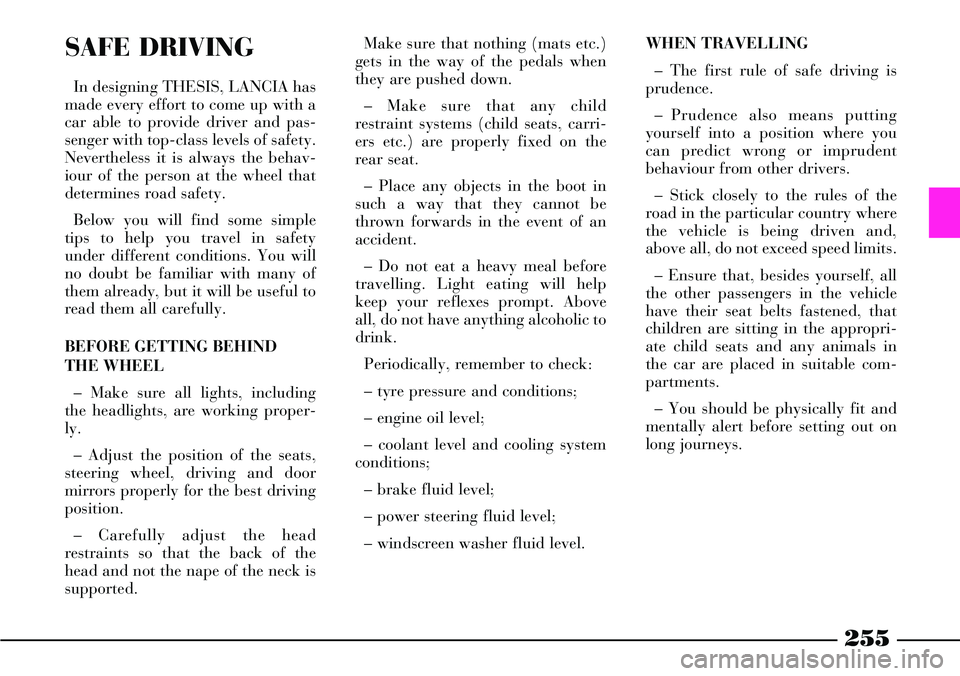
255
SAFE DRIVING
In designing THESIS, LANCIA has
made every effort to come up with a
car able to provide driver and pas-
senger with top-class levels of safety.
Nevertheless it is always the behav-
iour of the person at the wheel that
determines road safety.
Below you will find some simple
tips to help you travel in safety
under different conditions. You will
no doubt be familiar with many of
them already, but it will be useful to
read them all carefully.
BEFORE GETTING BEHIND
THE WHEEL
– Make sure all lights, including
the headlights, are working proper-
ly.
– Adjust the position of the seats,
steering wheel, driving and door
mirrors properly for the best driving
position.
– Carefully adjust the head
restraints so that the back of the
head and not the nape of the neck is
supported. Make sure that nothing (mats etc.)
gets in the way of the pedals when
they are pushed down.
– Make sure that any child
restraint systems (child seats, carri-
ers etc.) are properly fixed on the
rear seat.
– Place any objects in the boot in
such a way that they cannot be
thrown forwards in the event of an
accident.
– Do not eat a heavy meal before
travelling. Light eating will help
keep your reflexes prompt. Above
all, do not have anything alcoholic to
drink.
Periodically, remember to check:
– tyre pressure and conditions;
– engine oil level;
– coolant level and cooling system
conditions;
– brake fluid level;
– power steering fluid level;
– windscreen washer fluid level. WHEN TRAVELLING
– The first rule of safe driving is
prudence.
– Prudence also means putting
yourself into a position where you
can predict wrong or imprudent
behaviour from other drivers.
– Stick closely to the rules of the
road in the particular country where
the vehicle is being driven and,
above all, do not exceed speed limits.
– Ensure that, besides yourself, all
the other passengers in the vehicle
have their seat belts fastened, that
children are sitting in the appropri-
ate child seats and any animals in
the car are placed in suitable com-
partments.
– You should be physically fit and
mentally alert before setting out on
long journeys.
Page 258 of 386
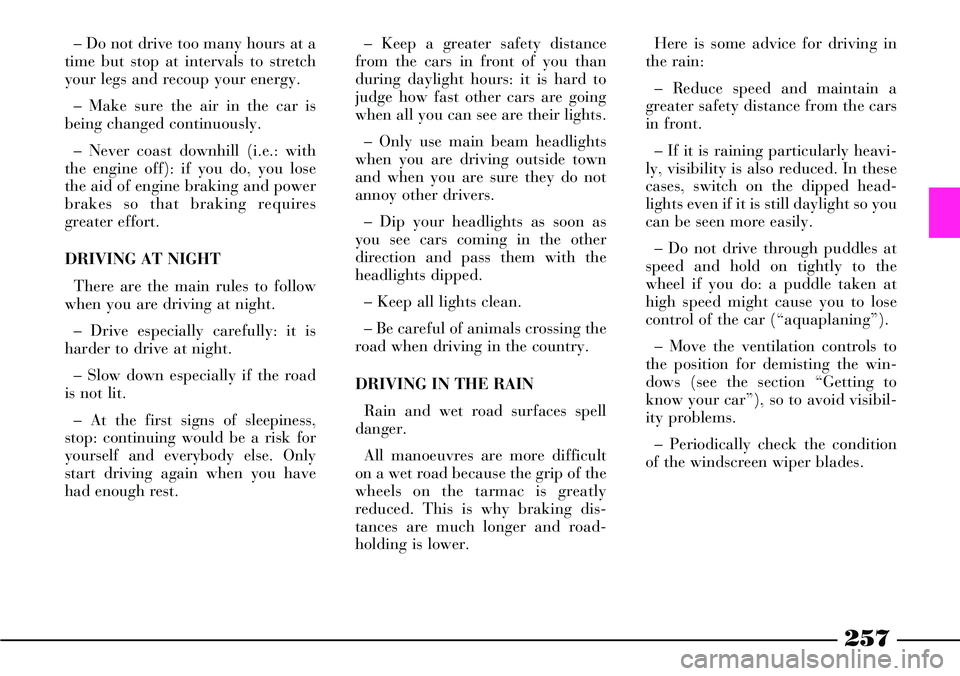
257
– Keep a greater safety distance
from the cars in front of you than
during daylight hours: it is hard to
judge how fast other cars are going
when all you can see are their lights.
– Only use main beam headlights
when you are driving outside town
and when you are sure they do not
annoy other drivers.
– Dip your headlights as soon as
you see cars coming in the other
direction and pass them with the
headlights dipped.
– Keep all lights clean.
– Be careful of animals crossing the
road when driving in the country.
DRIVING IN THE RAIN
Rain and wet road surfaces spell
danger.
All manoeuvres are more difficult
on a wet road because the grip of the
wheels on the tarmac is greatly
reduced. This is why braking dis-
tances are much longer and road-
holding is lower.Here is some advice for driving in
the rain:
– Reduce speed and maintain a
greater safety distance from the cars
in front.
– If it is raining particularly heavi-
ly, visibility is also reduced. In these
cases, switch on the dipped head-
lights even if it is still daylight so you
can be seen more easily.
– Do not drive through puddles at
speed and hold on tightly to the
wheel if you do: a puddle taken at
high speed might cause you to lose
control of the car (“aquaplaning”).
– Move the ventilation controls to
the position for demisting the win-
dows (see the section “Getting to
know your car”), so to avoid visibil-
ity problems.
– Periodically check the condition
of the windscreen wiper blades. – Do not drive too many hours at a
time but stop at intervals to stretch
your legs and recoup your energy.
– Make sure the air in the car is
being changed continuously.
– Never coast downhill (i.e.: with
the engine off): if you do, you lose
the aid of engine braking and power
brakes so that braking requires
greater effort.
DRIVING AT NIGHT
There are the main rules to follow
when you are driving at night.
– Drive especially carefully: it is
harder to drive at night.
– Slow down especially if the road
is not lit.
– At the first signs of sleepiness,
stop: continuing would be a risk for
yourself and everybody else. Only
start driving again when you have
had enough rest.
Page 261 of 386
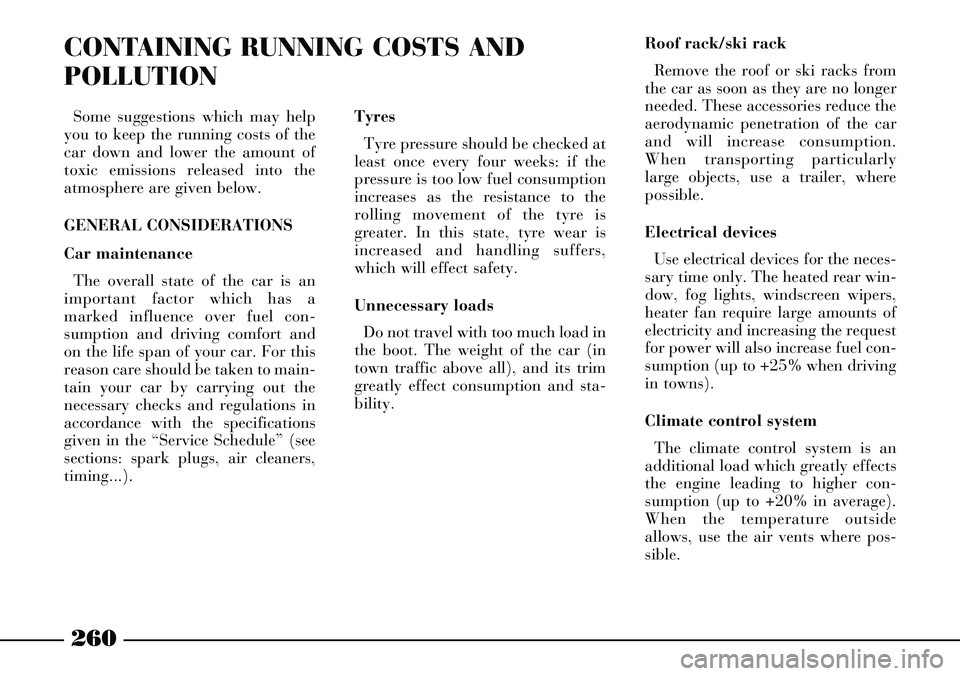
260
CONTAINING RUNNING COSTS AND
POLLUTION
Some suggestions which may help
you to keep the running costs of the
car down and lower the amount of
toxic emissions released into the
atmosphere are given below.
GENERAL CONSIDERATIONS
Car maintenance
The overall state of the car is an
important factor which has a
marked influence over fuel con-
sumption and driving comfort and
on the life span of your car. For this
reason care should be taken to main-
tain your car by carrying out the
necessary checks and regulations in
accordance with the specifications
given in the “Service Schedule” (see
sections: spark plugs, air cleaners,
timing...).Tyres
Tyre pressure should be checked at
least once every four weeks: if the
pressure is too low fuel consumption
increases as the resistance to the
rolling movement of the tyre is
greater. In this state, tyre wear is
increased and handling suffers,
which will effect safety.
Unnecessary loads
Do not travel with too much load in
the boot. The weight of the car (in
town traffic above all), and its trim
greatly effect consumption and sta-
bility.Roof rack/ski rack
Remove the roof or ski racks from
the car as soon as they are no longer
needed. These accessories reduce the
aerodynamic penetration of the car
and will increase consumption.
When transporting particularly
large objects, use a trailer, where
possible.
Electrical devices
Use electrical devices for the neces-
sary time only. The heated rear win-
dow, fog lights, windscreen wipers,
heater fan require large amounts of
electricity and increasing the request
for power will also increase fuel con-
sumption (up to +25% when driving
in towns).
Climate control system
The climate control system is an
additional load which greatly effects
the engine leading to higher con-
sumption (up to +20% in average).
When the temperature outside
allows, use the air vents where pos-
sible.
Page 270 of 386
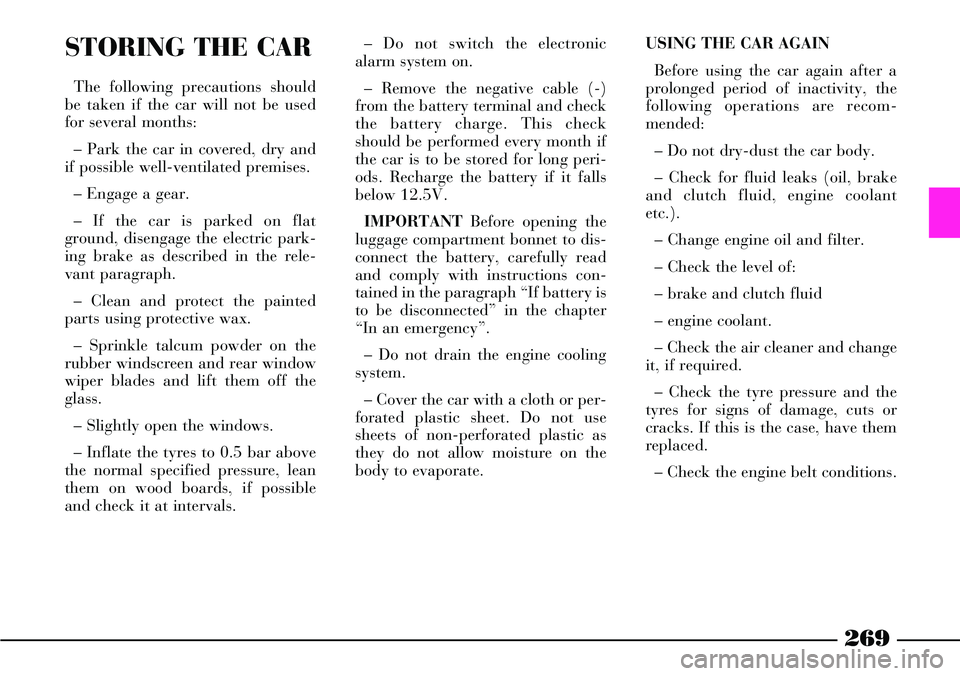
269
USING THE CAR AGAIN
Before using the car again after a
prolonged period of inactivity, the
following operations are recom-
mended:
– Do not dry-dust the car body.
– Check for fluid leaks (oil, brake
and clutch fluid, engine coolant
etc.).
– Change engine oil and filter.
– Check the level of:
– brake and clutch fluid
– engine coolant.
– Check the air cleaner and change
it, if required.
– Check the tyre pressure and the
tyres for signs of damage, cuts or
cracks. If this is the case, have them
replaced.
– Check the engine belt conditions.STORING THE CAR
The following precautions should
be taken if the car will not be used
for several months:
– Park the car in covered, dry and
if possible well-ventilated premises.
– Engage a gear.
– If the car is parked on flat
ground, disengage the electric park-
ing brake as described in the rele-
vant paragraph.
– Clean and protect the painted
parts using protective wax.
– Sprinkle talcum powder on the
rubber windscreen and rear window
wiper blades and lift them off the
glass.
– Slightly open the windows.
– Inflate the tyres to 0.5 bar above
the normal specified pressure, lean
them on wood boards, if possible
and check it at intervals.– Do not switch the electronic
alarm system on.
– Remove the negative cable (-)
from the battery terminal and check
the battery charge. This check
should be performed every month if
the car is to be stored for long peri-
ods. Recharge the battery if it falls
below 12.5V.
IMPORTANT Before opening the
luggage compartment bonnet to dis-
connect the battery, carefully read
and comply with instructions con-
tained in the paragraph “If battery is
to be disconnected” in the chapter
“In an emergency”.
– Do not drain the engine cooling
system.
– Cover the car with a cloth or per-
forated plastic sheet. Do not use
sheets of non-perforated plastic as
they do not allow moisture on the
body to evaporate.
Page 271 of 386

270
– Reconnect the negative battery
terminal (-) after checking the bat-
tery charge.
IMPORTANT Before connecting
the battery again carefully read and
comply with instructions contained
in the paragraph “If battery is to be
disconnected” in the chapter “In an
emergency”.
– With the gear lever to neutral,
start the engine and let it idle a few
minutes, pressing the clutch pedal
repeatedly.
This operation must be
carried out outdoor.
Exhaust gas contains car-
bon monoxide, an extremely
toxic gas.USEFUL
ACCESSORIES
In addition to the legal require-
ments we recommend keeping the
following in the car (fig. 2):
– first-aid kit with non-alcoholic
base disinfectant, sterile gauze, a roll
of gauze bandage, plasters, etc.,
– torch,
– round-nosed scissors,
– work gloves,
- fire extinguisher.
These articles are all available from
Lineaccessori Lancia range.
fig. 2
L0A0170b
Page 286 of 386

285
SIDE DIRECTION INDICATORS
(fig. 25)
To replace the bulb:
1) Push the lens in direction 1,
press tab Aand remove the cluster
from the back 2.
2) Turn the direction indicator
anticlockwise and remove the bulb
holder B.
3) Remove bulb Cand replace it.
4) Refit the direction indicator in
the bulb holder turning it clockwise.
5) Refit the direction indicator on
the fender first inserting the front
part and then pressing the rear part
until it fits. If the front fog lights are
not adjusted properly,
they could annoy other
drivers. Contact a Lancia
Dealership for a check and any
required adjustments.
fig. 24
L0A0154b
fig. 25
L0A0121b
FRONT FOG LIGHTS (where
provided) (fig. 24)
To replace front fog lights it is nec-
essary to operate under the vehicle,
after removing the protective cover
under the engine. For this reason, it
is suggested to have the bulbs
replaced at a Lancia Dealership.
Page 304 of 386
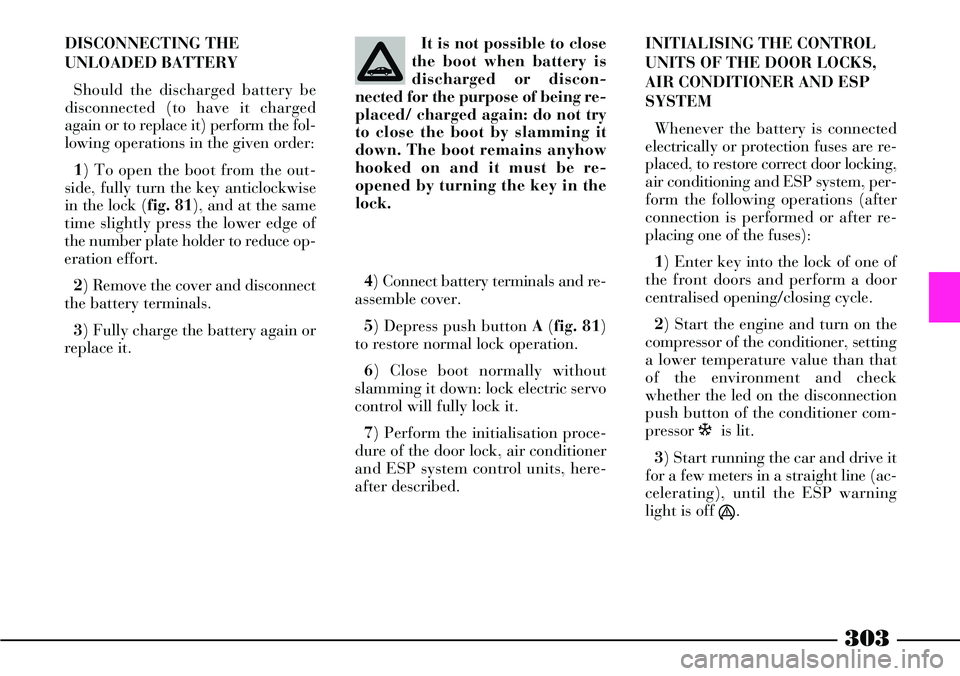
303
DISCONNECTING THE
UNLOADED BATTERY
Should the discharged battery be
disconnected (to have it charged
again or to replace it) perform the fol-
lowing operations in the given order:
1) To open the boot from the out-
side, fully turn the key anticlockwise
in the lock (fig. 81), and at the same
time slightly press the lower edge of
the number plate holder to reduce op-
eration effort.
2) Remove the cover and disconnect
the battery terminals.
3) Fully charge the battery again or
replace it.4) Connect battery terminals and re-
assemble cover.
5) Depress push button A(fig. 81)
to restore normal lock operation.
6) Close boot normally without
slamming it down: lock electric servo
control will fully lock it.
7) Perform the initialisation proce-
dure of the door lock, air conditioner
and ESP system control units, here-
after described.INITIALISING THE CONTROL
UNITS OF THE DOOR LOCKS,
AIR CONDITIONER AND ESP
SYSTEM
Whenever the battery is connected
electrically or protection fuses are re-
placed, to restore correct door locking,
air conditioning and ESP system, per-
form the following operations (after
connection is performed or after re-
placing one of the fuses):
1) Enter key into the lock of one of
the front doors and perform a door
centralised opening/closing cycle.
2) Start the engine and turn on the
compressor of the conditioner, setting
a lower temperature value than that
of the environment and check
whether the led on the disconnection
push button of the conditioner com-
pressor òis lit.
3) Start running the car and drive it
for a few meters in a straight line (ac-
celerating), until the ESP warning
light is off
á. It is not possible to close
the boot when battery is
discharged or discon-
nected for the purpose of being re-
placed/ charged again: do not try
to close the boot by slamming it
down. The boot remains anyhow
hooked on and it must be re-
opened by turning the key in the
lock.
Page 306 of 386

305
Under no circumstances
should a battery charger
be used to start the
engine: it could damage the elec-
tronic systems and in particular
the ignition and injection control
units.Carefully clean the
threading before fastening
the tow ring. Before start-
ing to tow the car, make sure the
ring has been fully fastened. Never try to charge a
frozen battery: first let it
thaw out, otherwise it
may bust. If the battery has
frozen, check that the internal
elements are not broken (risk of
short circuit) and that the casing
is not cracked causing the acid to
leak out. This acid is poisonous
and corrosive.
TOWING THE CAR
The tow ring provided with the car
is to be found in the tool box under
the boot carpet.
To fit the tow ring proceed as fol-
lows:
– Remove the clipped in Acover
from the front (fig. 82) or rear
bumper (fig. 83), by using a screw-
driver as a lever in the point shown
in the figure.IMPORTANT To carry out this
operation, if you use the provided
flat-head screwdriver, cover its head
with a piece of cloth to prevent paint
damaging.
– Screw the tow ring Bin its hous-
ing.
fig. 82
L0A0090b
fig. 83
L0A0091b
Page 307 of 386
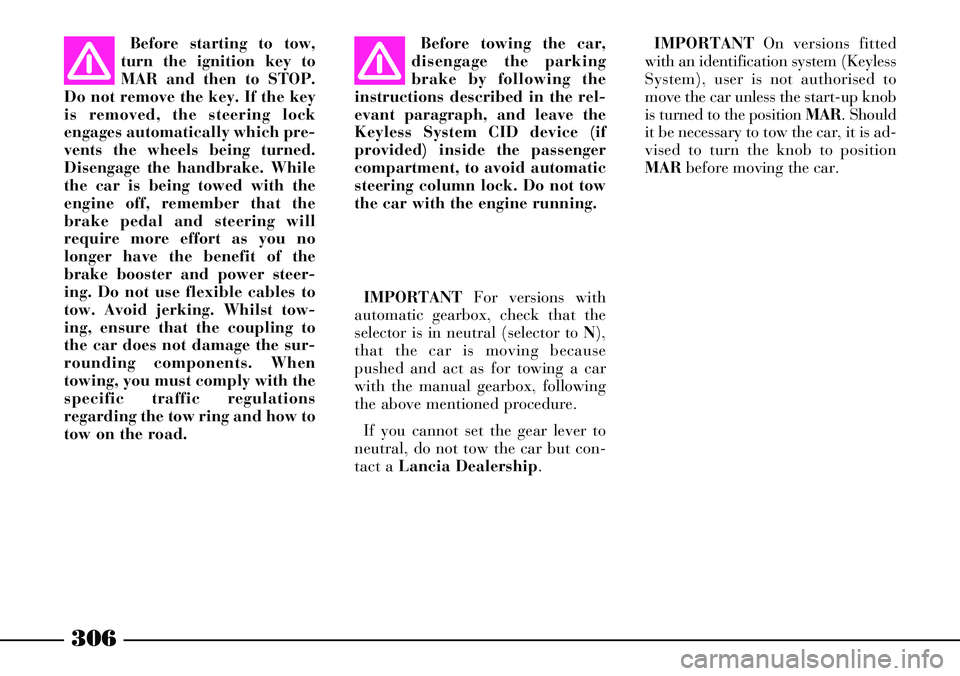
306
Before towing the car,
disengage the parking
brake by following the
instructions described in the rel-
evant paragraph, and leave the
Keyless System CID device (if
provided) inside the passenger
compartment, to avoid automatic
steering column lock. Do not tow
the car with the engine running. Before starting to tow,
turn the ignition key to
MAR and then to STOP.
Do not remove the key. If the key
is removed, the steering lock
engages automatically which pre-
vents the wheels being turned.
Disengage the handbrake. While
the car is being towed with the
engine off, remember that the
brake pedal and steering will
require more effort as you no
longer have the benefit of the
brake booster and power steer-
ing. Do not use flexible cables to
tow. Avoid jerking. Whilst tow-
ing, ensure that the coupling to
the car does not damage the sur-
rounding components. When
towing, you must comply with the
specific traffic regulations
regarding the tow ring and how to
tow on the road.IMPORTANTFor versions with
automatic gearbox, check that the
selector is in neutral (selector to N),
that the car is moving because
pushed and act as for towing a car
with the manual gearbox, following
the above mentioned procedure.
If you cannot set the gear lever to
neutral, do not tow the car but con-
tact a Lancia Dealership.IMPORTANTOn versions fitted
with an identification system (Keyless
System), user is not authorised to
move the car unless the start-up knob
is turned to the position MAR. Should
it be necessary to tow the car, it is ad-
vised to turn the knob to position
MAR before moving the car.
Page 313 of 386

312
SERVICE SCHEDULE
20 40 60 80 100 120 140 160 180 thousands of kilometres
ççççç çççç
ççççç çççç
ççççç çççç
çç çç
ççççç çççç
ççççç çççç
çç
çç çç
ççççç çççç
çç
çç çç
ççççç çççç
ççççç ççççCheck tyre conditions and wear; adjust pressure, if required
Check primary and secondary battery charge status
Check wear of windscreen/rear window blades
Check rear disc brake pad wear
Inspect conditions of: underbody protection and outside
bodywork, piping (exhaust - fuel lines - brake lines), rubber parts
(boots, sleeves, bushings, etc.), brake and fuel line hoses
Check for bonnet and boot lock cleanness, lever cleanness
and lubrication
Sight check for conditions of Poly-V accessory drive belt
Check diesel engine smokiness in exhaust
Replace fuel filter (JTD versions)
Check fuel evaporation system operation
Replace air cleaner cartridge (petrol versions)
Replace air cleaner cartridge (JTD versions)
Check and top up fluids (engine coolant, brakes,
hydraulic clutch, power steering, windscreen washer, battery, etc.)